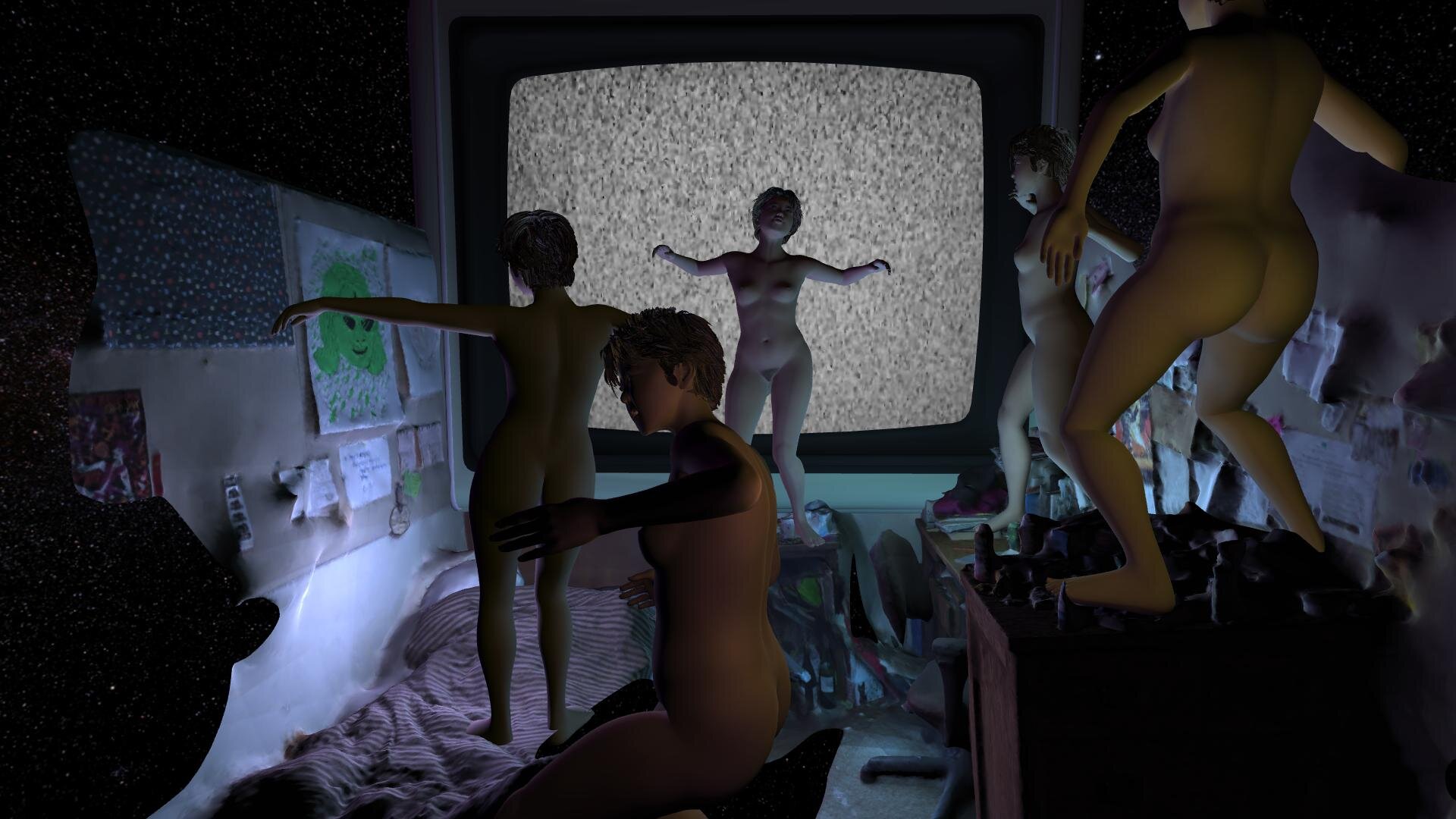by Matt Turner
Sheffield Doc/Fest’s new-look ‘Arts’ exhibitions explored notions of home and time across spaces both physical and virtual, posing intriguing questions with its variation of content, style, and tone.
The Blind Rabbit (Pallavi Paul, 2021)
Arts exhibitions attached to film festivals can often feel like an afterthought, an addendum to the main event rather than something given due time and consideration. When the pandemic put a pause on the in-person festival experience, organisers were provided with room to reimagine how art could be exhibited within a film festival context. For most festivals, this meant transplanting artworks into virtual environments or commissioning work specifically for the web, but for their 2021 edition, Sheffield Doc/Fest staged a tentative return to the world, welcoming a limited, mostly local audience to in-person events. As part of this, the festival reworked its arts exhibition. Retitled from ‘Alternate Realities’ to just ‘Arts’, virtual reality—which has recently been the dominant form within film festival art exhibitions—was conspicuously absent. Moving image work instead made up the majority of the programme, which consisted of two large group exhibitions (one presented entirely on the web, and one available both in venues and online), a supplementary exhibition placing two artists (Emily Chao and Al Wong) in an intergenerational dialogue, and several additional commissions (new work from Alex Tyson and Charlotte Jarvis, and a temporary online radio station broadcasting commissioned performances, discussions, readings, and sound art). Far from an afterthought, Doc/Fest’s art exhibition was, if anything, a little too full, feeling like an entire second festival tethered to the main one.
The ‘Here in this Room’ exhibition took “domestic ambience” and “domestic surrealism” as its focus, offering a compellingly wide-ranging survey of differing treatments of the idea of home. In some works, this had negative connotations. Basir Mahmood’s slippery Sunsets, everyday (2020) examines domestic violence through a multilayered assemblage of behind-the-scenes material showing a film crew that the artist had instructed to depict the subject, whilst Julie Ramage’s How to order online (2021) explores an internal trade and communication system developed by prison inmates in lieu of more formalised networks of exchange. Both works complicate a straightforward documentary form in order to encompass the complexities of their difficult subjects. Peeling back the curtain of the production process, these works expose all the skeletal components that make a film by making the acts of construction explicit, whilst also making clear the acts and gestures of the people involved who come together to make the film. A prison with no people held inside of it is just a structure, just as a film set is without the crew. Heesoo Kwon’s A Ritual for Metamorphosis (2019) also takes place within a set of sorts. In this work, the artist makes an after-the-fact intervention into her family’s home videos by anarchically superimposing a naked dancing CG avatar of herself that disrupts this oppressively heteronormative, patriarchal vision of domesticity.
A Ritual for Metamorphosis (Heesoo Kwon, 2019)
Others, like Séamus Harahan's There’s A Weight On You But You Can’t Feel It (2008-18), showed something closer to solace. Filmed from the window of his home, Harahan’s strikingly simple videos see the artist mix gentle observances (scenes show kids throwing stones, tree branches waving in the wind) with non-diegetic soundtracks (such as music by Robyn G Shiels and PJ Harvey) to unexpectedly moving effect. Geraldine Snell’s Still Life Moving (2020), an arresting sequence depicting a cycle of fluctuations of soft light cast through objects within domestic settings, was even less ostentatious. Whilst these two works function fine on the web, it was through their installation that they gained much of their potency. Harahan’s videos were presented on a floor-level monitor sat in front of a street-facing window in Sheffield’s Site Gallery, such that viewers had their own serendipitously voyeuristic experience whilst viewing the work. Snell’s work was projected directly onto a dark wall in the dingy S1 Artspace, mirroring the way that sunlight moves over interior surfaces throughout a day.
If these two works demonstrated the importance of seeing art amongst people and within actual spaces, this effect was heightened by the works that were screened in cinemas, a decision that did raise questions around what actually made the arts exhibition distinct from the festival’s film programme, especially given the festival’s increasing proclivity towards more outlier forms of non-fiction filmmaking. Of these, a screening of Georges Lacombe’s La Zone (1929) that took place in the Abbeydale Picture House, a majestic theatre built in 1920 was noteworthy. A stunning poetic-realist documentary about ragpickers living on the outskirts of Paris at the time, its connection to the exhibition’s theme was admittedly somewhat tenuous, but it was an event with a sense of grandeur that made a good contrast to the intimacy of the gallery exhibitions. After a year in which, as curator Herb Shellenberger notes in his introduction, many people will have been unified in being “stuck at home”, it was interesting to see so much variation in content, style, and tone regarding what such an experience can entail.
On Time (Gian Spina, 2016)
In her introduction for the parallel online exhibition ‘Right on Time’, curator Soukaina Aboulaoula described the show as a “scavenger hunt” through which visitors are able to “explore different historical and personal experiences/memories.” As well as defining well what it is like to watch work online, this description is apt, as whilst ‘Here in this Room’ explores subtle variations on a straightforward theme (‘home’), ‘Right on Time’ is considerably broader, bringing all sorts of disparate subject material together under a much looser organising principle (‘time’). Also made mostly of moving image works, an essayistic, searching style of filmmaking was popular across this exhibition. In Tabita Rezaire’s dense and beguiling Mamelles Ancestrales (2019), the artist visits various sites where stone monoliths known as ‘megaliths’ can be found, speaking to locals about their understanding of this phenomenon. In their responses, presented as ethereal floating heads overlain over flat observational footage, cultural, spiritual, and scientific interpretations are all presented with no one form of knowledge given precedence. Pallavi Paul’s The Blind Rabbit (2021) is equally rich and thought-provoking, using a creative approach to explore histories of police violence in Delhi, both recent and past, that have been suppressed from the official record. Collating different stories and testimonies and interweaving these with various pieces of security footage and clandestine recordings, Paul establishes a searing, anguished essay that crosses timelines, sites, and sources to create a patchwork portrait of systemic oppression that creatively overcomes the paucity of available source materials that a silencing causes. Drawing from varying sources, the artist imaginatively fills the gaps left in the historic record using a mix of invention, speculation, and mystification, using an allegorical story about a tiger as a frame for the film, between which comes a fragmentary mix of text drawn from quoted sources or from recovered police logs and scattered verbal testimony, alongside a mix of surreal, abstract imagery and shockingly direct sound recordings and CCTV footage.
Gian Spina’s On Time (2016) acted as a perfect encapsulation of the exhibition’s ideas. Consisting of an extended monologue detailing varying interpretations of the concept of time set to an array of imagery recorded over a decade, in this remarkable essay film the artist reflects on collective memory and the making of cultural record, plus shifting understandings of the meaning of time amidst political unrest. “I propose a reflection about time,” says Spina, “its multiple durations, its simultaneities, its intervals, and above all, its relation with memory”, before later wondering how we might best “represent the present”. In ‘Right on Time’, Aboulaoula presents varying works that suggest that one way to do this is by collapsing the distance between past and present, and acknowledging that there is no single way of understanding how time moves or how it should be measured. Both of these group exhibitions feel timely as a result of their relation to the pandemic, a period in which many were confined to their homes and forced to reckon with a slackened sense of time. Expanding beyond the seemingly narrow constraints of their curatorial propositions, they centre a plurality of perspectives that shift and unsettle orthodox understandings of what ‘home’ and ‘time’ can or could mean.
Sheffield Doc/Fest ran from 4 - 13 June 2021
Matt Turner is a film, arts, and culture writer born and based in London.



